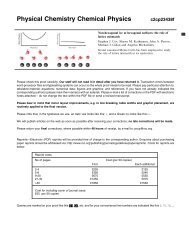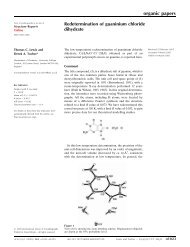ADVANCED USERS DMACRYS & NEIGHCRYS manual Manual ...
ADVANCED USERS DMACRYS & NEIGHCRYS manual Manual ...
ADVANCED USERS DMACRYS & NEIGHCRYS manual Manual ...
Create successful ePaper yourself
Turn your PDF publications into a flip-book with our unique Google optimized e-Paper software.
analytical second derivatives being generated in the relaxation step, because this is faster and usually almost<br />
as accurate.<br />
Error messages<br />
Error - cannot locate a lower energy along a negative eigenvalue<br />
This indicates that even the smallest displacement selected by <strong>DMACRYS</strong> was too large, and none of the<br />
points investigated were lower in energy than the original saddle point structure.<br />
THE FORCE CONSTANT MATRIX IS AS FOLLOWS<br />
THE GRADIENT VECTOR IS AS FOLLOWS<br />
The force constant matrix and gradient vector may be printed by setting PRIN PLUT 01000. If just the<br />
gradient vector is required, set PRIN PLUT 03000 (first and last cycle only) or PRIN PLUT 04000 (Each<br />
cycle). There are 6*MOLS + 6 elements. The order of the elements is<br />
x, y and z derivatives of each molecule in the sorted order. This is followed by the torsions for each<br />
molecule.<br />
6 components of the bulk strain derivatives.<br />
Note that there are mixed second derivatives between all three types. The elements of the matrix are not<br />
scaled to eV Angstrom units. To convert to eV Angstrom units, multiply<br />
W or G Position Multiplication Resulting Units<br />
From<br />
To<br />
factor<br />
Gradient 1 6*MOLS<br />
14.3994584 (eV Å) -1<br />
2<br />
RLAT<br />
6*MOLS<br />
ENDS<br />
14.3994584 (eV Å) -2<br />
3<br />
RLAT<br />
Matrix 1,1 6*MOLS,6*MOLS 14.3994584 (eV Å) -2<br />
3<br />
RLAT<br />
1,6*MOLS<br />
6*MOLS,END 14.3994584 (eV Å) -3<br />
4<br />
RLAT<br />
6*MOLS,6*MOLS END,END<br />
14.3994584<br />
5<br />
RLAT<br />
(eV Å) -4<br />
The lattice vectors, basis species types and positions will be written to FORTRAN unit 8. This is by default<br />
for <strong>DMACRYS</strong>.<br />
3.10 PROPERTIES CALCULATIONS<br />
The elastic stiffness tensor 1 and k=0 phonon frequencies 2 of the perfect crystal at 0 K are estimated within<br />
<strong>DMACRYS</strong> from the second derivatives of the energy with respect to rigid body motions. The omission of<br />
the NOPR directive means that the full second derivative matrix is calculated numerically from the<br />
analytical gradients. The time taken to carry out the calculations is increased significantly.<br />
The calculation should start from a lattice energy minimum; otherwise the relaxation may change the<br />
conventional Cartesian reference frame, leading to an error in the definition of the elastic constants. The<br />
restarting of the calculation may lead to insignificant small changes. The values that are changed very<br />
slightly by the NOPR directive being omitted are:<br />
• Ewald summed charge-charge energy<br />
• Inter-molecular charge-charge energy<br />
• Total charge-dipole energy<br />
• Total dipole-dipole energy<br />
• Total charge-dipole+dipole-dipole energy<br />
• Higher multipole interaction energy<br />
• Total isotropic repulsion-dispersion<br />
• The Eigenvalues for the representations<br />
42







